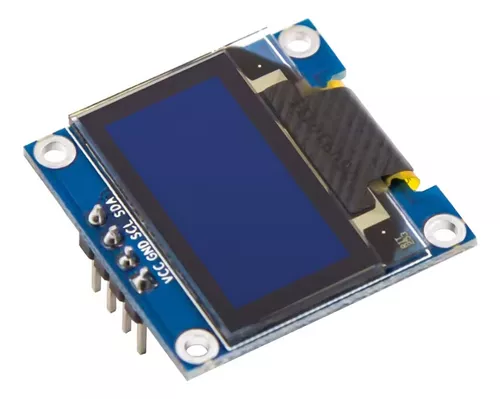[ESP/ENG] 🌟 Módulo de pantalla OLED SSD1306: Visualización avanzada para tus proyectos 🖥️✨ 🌟 SSD1306 OLED Display Module: Advanced Display for Your Projects 🖥️✨
[ESP]
¡Hola, apasionados de la electrónica y la tecnología! 👋
Hoy vamos a explorar el módulo de pantalla OLED SSD1306, una herramienta increíble para mostrar información en tus proyectos electrónicos de manera compacta y eficiente.
📌 ¿Qué es el módulo SSD1306?
El SSD1306 es un módulo de pantalla OLED (Diodo Orgánico de Emisión de Luz) que proporciona una solución de visualización compacta y de bajo consumo, ideal para microcontroladores como Arduino y ESP8266.

Características principales:
- Resolución: Comúnmente 128x64 píxeles.
- Tecnología OLED: No requiere retroiluminación, ya que cada píxel emite su propia luz.
- Interfaces: I2C y SPI.
- Bajo consumo de energía.
- Tamaño compacto: Disponible en diferentes dimensiones (generalmente 0.96").
🛠️ Conexión del SSD1306 a Arduino
La interfaz más utilizada es I2C, que solo requiere dos pines: SDA y SCL.
Conexión básica:

💻 Ejemplo de código en Arduino
Para este ejemplo, utilizaremos la biblioteca Adafruit SSD1306 y su dependencia Adafruit GFX.
Código de ejemplo:


💡 Nota: Asegúrate de instalar las bibliotecas necesarias desde el Administrador de Bibliotecas de Arduino IDE.
🌈 Aplicaciones del SSD1306
- 1️⃣ Interfaz de usuario: Visualización de menús o estados en proyectos electrónicos.
- 2️⃣ Monitoreo: Muestra lecturas de sensores como temperatura, humedad, o voltaje.
- 3️⃣ Indicadores gráficos: Añade gráficos simples o animaciones a tus proyectos.
- 4️⃣ Proyectos IoT: Presenta información clave como estado de conexión, datos en tiempo real, etc.
⚠️ Consideraciones importantes
- 1️⃣ Dirección I2C: Verifica la dirección del módulo (generalmente 0x3C o 0x3D).
- 2️⃣ Resolución: Usa gráficos adecuados para aprovechar al máximo la resolución de la pantalla.
- 3️⃣ Consumo de memoria: La biblioteca puede consumir bastante RAM, especialmente en microcontroladores con memoria limitada.
🚀 Conclusión
El módulo SSD1306 es una opción versátil y eficiente para proyectos que requieren visualización compacta. Desde sistemas IoT hasta proyectos educativos, esta pantalla OLED es una adición valiosa para cualquier creador.
📢 ¡Gracias por explorar conmigo el módulo SSD1306! 🌟
Espero que esta guía te inspire a integrarlo en tus proyectos. Si tienes dudas o quieres compartir tus resultados, ¡deja un comentario! 📝
🔔 No te pierdas nuestras próximas publicaciones sobre módulos y herramientas avanzadas. 🌐
🤝 Únete a nuestra comunidad para aprender y compartir conocimientos sobre electrónica y visualización. 💬
🌟 Continúa explorando y desarrollando: Mantente activo en Hive para descubrir nuevas formas de integrar pantallas en tus proyectos. ¡Hasta la próxima! 🚀✨
[ENG]
Hello, electronics and technology enthusiasts! 👋
Today we are going to explore the SSD1306 OLED display module, an amazing tool to display information in your electronic projects in a compact and efficient way.
📌 What is the SSD1306 module?
The SSD1306 is an OLED (Organic Light Emitting Diode) display module that provides a compact and low-power display solution, ideal for microcontrollers such as Arduino and ESP8266.

Main features:
- Resolution: Typically 128x64 pixels.
- OLED technology: No backlight required, as each pixel emits its own light.
- Interfaces: I2C and SPI.
- Low power consumption.
- Compact size: Available in different dimensions (usually 0.96").
🛠️ Connecting SSD1306 to Arduino
The most commonly used interface is I2C, which only requires two pins: SDA and SCL.
Basic connection:

💻 Arduino code example
For this example, we will use the Adafruit SSD1306 library and its Adafruit GFX dependency.
Code example:


💡 Note: Make sure to install the required libraries from the Arduino IDE Library Manager.
🌈 SSD1306 Applications
- 1️⃣ User Interface: Displaying menus or status in electronic projects.
- 2️⃣ Monitoring: Displays sensor readings such as temperature, humidity, or voltage.
- 3️⃣ Graphical Indicators: Add simple or complex graphics to your projects. animations to your projects.
- 4️⃣ IoT Projects: Present key information such as connection status, real-time data, etc.
⚠️ Important Considerations
- 1️⃣ I2C Address: Check the module address (usually 0x3C or 0x3D).
- 2️⃣ Resolution: Use suitable graphics to make the most of the screen resolution.
- 3️⃣ Memory Consumption: The library can consume quite a bit of RAM, especially on microcontrollers with limited memory.
🚀 Conclusion
The SSD1306 module is a versatile and efficient choice for projects that require compact display. From IoT systems to educational projects, this OLED display is a valuable addition for any creator.
📢 Thank you for exploring the SSD1306 module with me! 🌟
I hope this guide inspires you to integrate it into your projects. If you have questions or want to share your results, leave a comment! 📝
🔔 Don't miss our upcoming posts about advanced modules and tools. 🌐
🤝 Join our community to learn and share knowledge about electronics and visualization. 💬
Congratulations @profwhitetower! You have completed the following achievement on the Hive blockchain And have been rewarded with New badge(s)
You can view your badges on your board and compare yourself to others in the Ranking
If you no longer want to receive notifications, reply to this comment with the word
STOPHello profwhitetower!
It's nice to let you know that your article will take 9th place.
Your post is among 15 Best articles voted 7 days ago by the @hive-lu | King Lucoin Curator by keithtaylor
You receive 🎖 0.5 unique LUBEST tokens as a reward. You can support Lu world and your curator, then he and you will receive 10x more of the winning token. There is a buyout offer waiting for him on the stock exchange. All you need to do is reblog Daily Report 703 with your winnings.
Buy Lu on the Hive-Engine exchange | World of Lu created by szejq
STOPor to resume write a wordSTART